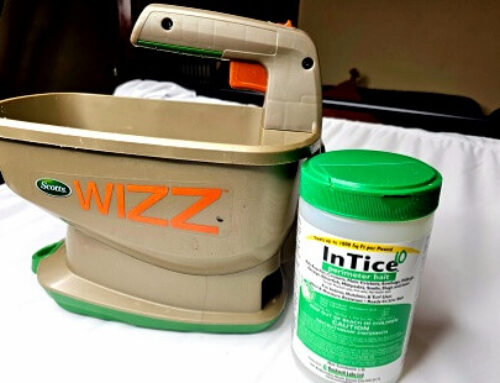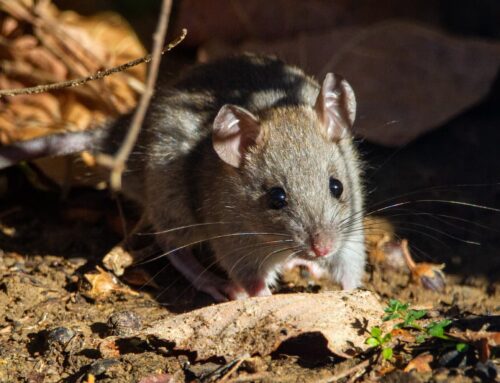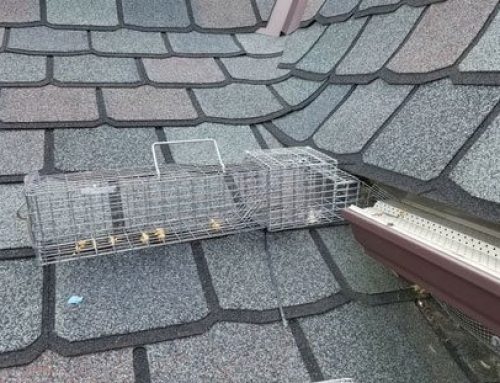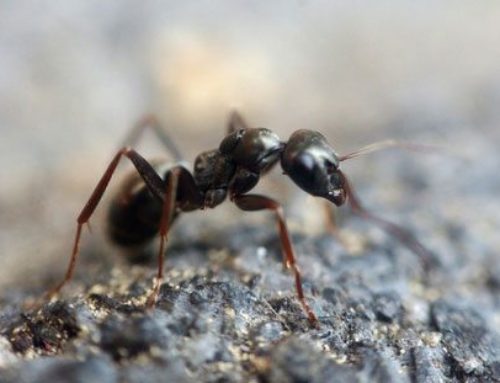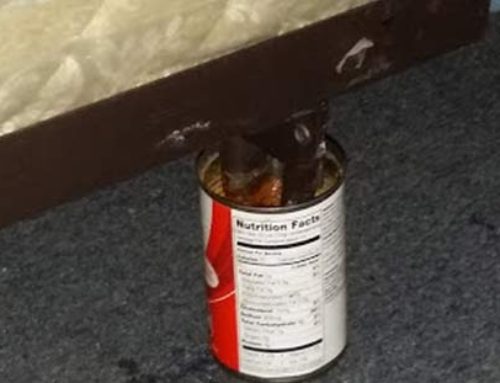Lakewood Exterminating- How To Control Pests At Your Home.
To view our Power Point From The Presentation Click Here!
Common Pests in Lakewood, OH:
- Mice
- Small Ants (Sugar/ Odorous House Ants, Pavement Ants)
- Grey Squirrels
- Spiders
- Rats
- Bed Bugs
- Yellowjackets And Other Stinging Insects
- Cockroaches
- Fleas
- Centipedes
- Carpenter Ants
- Fruit Flies
- House Flies
- Pantry Moths
- Silverfish
- Springtails
- Mosquitos
- Ticks
- Clover Mites
- Carpet Beetles
- Other Wildlife
Create a Plan of Action:
Before you run to the store in search of products that state they kill your target pest, develop a strategy.
Keep in mind that we all need food, shelter and water.
In order to control the population of any pest, consider manipulating these factors in the environment.
Can you remove food sources? (Rodents= Bird feeders, Spiders= flying insects, fleas= feral cats, other wildlife)
Can you remove shelter? Pests love to hide in the shadows. Eliminating clutter is key. Another example would be caulking around cabinets for cockroaches.
Manipulating the environment like this is called “cultural control” methods. There are two other control methods: Mechanical (vacuuming, steaming, traps) and Chemical.
First and foremost, your plan of action should implement cultural and mechanical control methods. Then use chemical control as a supplement to your plan, if you choose to use it.
Mice:

You have mice inside due to entry points on the exterior of your home.
Recommended Supplies:
- Inspection: Strong Flashlight, Knee Pads, Rubber Gloves, stool/ladder.
- Repairs: Strong Scissors. Copper Mesh (Chore Boy), Spray Foam, Sealant (not caulk), Potentially ¼” Hardware Fabric, and Mortar.
- Control Materials: Traps/ Rodenticide. Adhesive (to stick traps to sill plate), paper lunch bags (to place traps in), and food attractant for traps. Also have disinfectant and Ziploc baggies for carcass removal.
Interior Inspection: Locate Areas of Activity.
Droppings: Mice do not defecate in a specific latrine area. Mouse droppings will be scattered throughout infested locations. Locations with droppings are ideal areas to set traps.
Follow CDC guidelines on how to clean fecal matter. Generally, you will want to treat it with disinfectant, let it sit for 10-15 minutes. Then remove it in a way not to cause any particles to go airborne.
Sebum/ Grease Markings: Mice and other rodents have an oily material called sebum on their bodies. This protects them from the elements (water especially).
Mice will also follow pheromone (scent trails). Therefore, they will most often follow the same pathways.
When these paths become well used over time, sebum is left behind. Inspecting for visibly greasy residues can aid in identifying pathways, lead you to nesting sites/ entry points, and aid in trap placement.
Nesting Sites: Look for burrows and pathways in insulation. Mice will leave circular divots in insulation on top of basement foundation walls and in attics. Mice will expose their pathways by tamping down insulation in attics over time. By tracking mice back farther into the unfinished areas of the home, you can increase efficiency of your trapping efforts.
Exterior Inspection: Locate Entry Points.
Look Along the Foundation: Gaps around AC conduit is the most common entry point for mice. Check for gaps in mortar joints, vents and other utilities as they enter the structure.
Look Under Decks and Porches: Many Lakewood homes have terra cotta foundation block underneath decks and porches. This is the same material as clay pots. The mortar between the blocks often deteriorate, along with the blocks themselves. Also check along the rim joist on top of the foundation. Check where support joists attach to the structure too.
Other Areas to Inspect: Inspect the junction of additions and the main foundation wall.
Inspect the siding gap- which is the area between the top of the foundation and under the bottom row of siding.
There are a bunch of other potential entry points. If you are interested Check out our YouTube video on How Mice Get Into Homes.
Mouse Trapping:
- Most people catch around 6 mice.
- 10 traps is a good number to set out for normal infestations.
- 4 traps in the kitchen on the corners of appliances (stove, dishwasher, refrigerator).
- 6-10 traps in the basement on the sill plate.
The ledge on top of the basement wall is an ideal location for trap placement. Secure traps with a bit of caulk/ construction adhesive.
Sugar and Pavement Ants: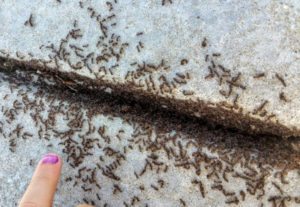
There Can Be Hundreds Of Thousands Of Ants In A Colony.
Not many of these ants leave their nests. At least until they get older. Once an ant is at the tail end of their usefulness, they are cast off as foragers. And some, if not many, find their way into your home. Wouldn’t you agree that 20 ants is a lot of ants to find inside?
Consider how spraying those 20 ants in the kitchen, will control a colony of ants that likely spreads across yours’ and your neighbor’s sidewalks and driveways.
What is spraying your foundation going to do to the population of ants outside?
Ants Inside:
Imagine a horde of ants exposing dropped food bits in your dining room. Or them relentlessly sneaking in for some cat food. All those ants have a pheromone trail leading from their nest to that food. It is a lot like those Sebum markings for the mice. While ants don’t leave dark goo behind, you can follow the line of ants. And if you have problems doing so, then strengthen the line of ants by putting out a delicious treat for them. Some capfuls of sugar water or whatever they might like. If there are a lot of ants in your house, drawn to specific locations, surely you will be able to track them back to a crevice. Once you do, you can place an assortment of ant bait at that point. That has cut off the part of the pheromone trail leading to your living space.
This is The Same Principle of Inspecting For Mice In Basements And Setting The Traps Along Their Pheromone Trails On The Basement Rim Joist.
Ants Outside:
Use the same concept outside as you did inside.
- Find And/ Or Develop Ant Trails.
- Track As Far Back To the Nest(s) As Possible.
- Treat Directly.
Carpenter Ants: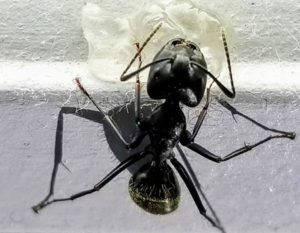
Carpenter ants have a main colony with a single Queen. Carpenter ant eggs need high humidity. Therefore, the main colony is within a tree. Worker ants move older larvae into areas with lower humidity to be raised into adults. These sites are called satellite colonies. They are primarily constructed in water damaged wood.
If you have water damaged wood components of the home, these might be areas to inspect:
Around windows and doors, behind gutters, around chimneys, porch pillars, plumbing leaks, around downspouts.
Carpenter ants are nocturnal. So track them after it gets dark. Go outside with a flashlight and find them. Place bait next to the ants. Search out the main colony and the satellite colony.
Look at tree trunks, stumps, fence posts, and around the foundation. One hot spot is on top of your overhead garage door.
Consider that the tree with the queen might not be on your property.
Carpenter Ants Can Be Picky Eaters.
Carpenter ants primarily feed on dead insects. Therefore, they can be picky feeders when trying to use ant bait on them. Granular bait seems to be the most effective in relation to their feeding habits. Keep in mind that Terro bait is not labeled for carpenter ants.
Alternatively, you can spray the base of tree trunks (up and out several feet).
You can also treat satellite colonies in walls/ window and door voids with foam pesticide products. These are aerosol cans with an applicator straw for crack and crevice application.
Grey Squirrels: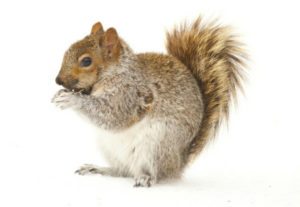
Grey squirrels are non-native, highly adaptable cavity dwellers. And they love exposing the construction flaws in our homes.
We highly recommend that you use a wildlife control company to handle the trapping and removal of nuisance wildlife. As a general rule of thumb, keep branches 15+ feet away from the roofline.
For squirrels traps need to be placed over the entry point, and adjacent to the entry point outside. Positive set traps must remain over the entry point for 1 week- prior to removal and repair to the entry point. Steel is the preferred material to use to repair entry points. This is due to the fact that they can gnaw through softer materials.
Spiders:
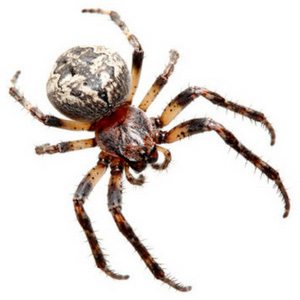
Spiders
People commonly state that spiders are good since they eat other insects. This is basically telling you that spiders are around your house because you have other insects for them to eat. The key to controlling spiders is by minimizing their food sources.
First, you can identify your spider by using this guide from Ohio Department of Natural Resources.
Then you can look up what that spider likes to eat. Then attempt to manage the population of those insects.
For example, many spiders found in our basements feed on potato bugs. These can be easily controlled by placing sticky traps in areas that spiders are found. You can also control them with applying granular bait.
2 Types Of Spiders:
Active Hunting
These are wolf spiders, black jumping spiders, grass spiders. Basically, the spiders that’ll run after their prey.
- Use Sticky Traps In Areas Of Activity.
- Eliminate harborage such as clutter.
- Treat the cracks and crevices where they live.
- Control the pests that they feed on.
Passive Hunting
These like the Charlotte’s Web spider/ orb weavers. The ones that have webs to catch their prey.
- Minimize the light that attracts flying insects, which is spider food. Closing blinds/ curtains at night helps. Along with using motion detectors on exterior security lights. Alternatively install yellow exterior light bulbs that do not attract flying insect spider food.
- If you don’t want the webs, don’t give them flying bugs to catch.
- Get a telescopic pole in the painting section of the home improvement stores. Purchase a webster duster from the window cleaning area.
- Use the two to knock down spiders and their webs.
- Perform web removal in conjunction with the natural sprays or the synthetic sprays. You can also spray the duster head with pesticide and then wipe effected areas.
Norway Rats: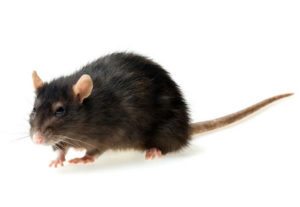
Norway Rats enter homes through the exterior (like mice). Or through the sewer lines. Most of the time it is a single rat that enters a home. Once a rat gets inside, it searches for food and nesting material. Dog/ pet food is the most common food source within a home. Rats cache food, just like squirrels store acorns. Once a rat stores enough food, it will be more difficult to catch.
Rats are neophobic. Which means they fear new objects.
As a result, if a rat has become familiar with your home before you set traps, then the traps will be seen as a new object. At that point, the rat will be more difficult to catch. You will want to remove all potential food sources including pet food, food waste in the garbage, produce sitting on counters, and any contained food that the rats can compromise. You will want to “properly” set traps as soon as possible. In many cases a plumber is required to make the proper repairs. A proper inspection should be performed to evaluate how it has gained access to the home.
Inspection For Entry Points
First, you will want to check the sewer lines. Most Lakewood homes have a basement toilet stall. Check this for a dried trap. Check to make sure you have a strainer on all floor drains. This includes your laundry drain basin. Keep in mind that there can be breaks in the drain stack above the basement.
Second, inspect outside. In most cases, when rats enter from the exterior, there is a food supply close by. This is usually from bird feeders or someone feeding wildlife nearby. Inspect the exterior as you would for mice. Rat holes need to be larger than a sharpie marker. These are usually significant sized holes, think golf ball sized holes.
Rats commonly enter homes from the sewers opposed to gaps outside the structure. Yet when they do, there is usually a confined space for them to occupy. Weep holes leading into enclosed front porches are a good example. Or rear additions with a crawlspace separate from the basement.
In search of rat burrows and nests outside; you will find a worn path, tamped down vegetation, or some semblance of a runway. Burrow entrances are often on the top of an elevated area, such as a retaining wall.
You may also see gnawed lattice around porches and decks.
Rat Trapping:
- Use the proper sized trap. Do not use mouse-sized traps.
- Avoid Glue Boards. Trying to catch a rodent the size of a kitten on a postcard sized area of glue is a bad idea. In most cases, the rat will escape from being stuck. As a result, the rat will likely be very hesitant to approach new objects. It can cause them to become “trap shy”.
- Use a few different styles of traps (Plastic Snap Traps, Wooden Snap Traps) Place a different kid of bait/ food attractant on the different styles of traps. That way if it avoids a certain appearance or odor, you have some options that could be more attractive.
- Use a lot of traps. In most cases, 25 snap traps in a basement is a good amount to set.
- Look for food caches. Look under appliances (dishwasher too), cabinet bases, under basement stairs, etc. If a rat has food stored, it is very unlikely to stick its head in your traps.
- Juvenile Rats are easier to catch. Older, more experienced rats are often more “neophobic” and “trap-shy”. Alpha- Males are the most difficult to catch.
Rats can be very difficult to catch if:
- They have food stored. Or if they have other food sources available.
- Have set off a trap yet were not caught.
- Are an alpha male.
- If traps are not set properly.
When you are having problems catching a rat:
- Add more traps.
- Pre-bait by placing traps with food on them, without setting the trigger. Once a rat feeds from the trap, set it.
- If a rat has gotten ahold of your food, you can use that specific food on a trap (preferably set these traps in the same location that the food was taken from.)
- Disguise traps by placing floor sweepings or dryer lint over the traps.
Best food to place on traps.
- Anything the rat may have already eaten from your home.
- Slim Jim beef jerky
- Bacon fat
Bed Bugs: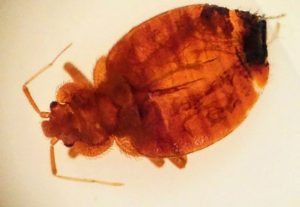
Bed Bug Treatments Are Best Left To Professionals. They are one of a couple species of living organisms that can mutate their mitochondrial DNA. As a result, they get stronger by inbreeding. Most infestations start by introducing a single pregnant female. Due to this, bed bugs become resistant to pesticides more readily than other pests. Most retail bed bug products are pyrethroid based. Since so many people have been applying pyrethroid products, they do not work all that well anymore. In resistant populations, you could spray a bunch of bed bugs directly and only kill 60- 80% of them.
Bed Bug Identification:
- Bed Bugs Have: Egg Capsules, Nymphs, and Adults.
- Black Feces is also a good identifier, along with shed exoskeletons.
- All life stages are clearly visible to the naked eye.
- Nymph stages look like small adults. The first couple of stages are small and pale yellow. As they molt further, they become larger and darker brownish-red.
Bed Bug Inspection:
- Bed Bugs will be found primarily within 5 feet of their host. In this case, they know where we are by sensing our heat, co2, odor/ vibrations.
- They can be found in secondary areas, when pesticides have been applied improperly, and when the population grows to a greater extent.
- Bed Bugs are soft bodied. Therefore, they prefer to sandwich themselves between two objects for protection.
- Except for in extreme cases, bed bugs do not remain on the human body after feeding.
Hotspots:
- The head of the bed.
- Mattress seams.
- Plastic corner pieces of box springs.
- Under the box springs, hiding around the edge of the black dust cover.
- Headboards.
- Couches.
Recommendations:
- Strip the bed.
- Launder bedding.
- Purchase high quality mattress and box spring encasements.
- Perform “focused vacuuming”.
- Install encasements.
- Treat bed frame, headboard, nightstands, under baseboard underneath the bed, couch and surrounding areas, and other areas where bed bugs were found.
- Launder bedding and inspect at least once per week.
- Do not abandon infested rooms.
- Do not remove furniture before treating it and containing it. (The #1-way bed bugs are introduced is through used furniture).
Stinging Insects: Yellowjackets, Carpenter Bees, Bumblebees, Bald Faced Hornet, Paper Wasps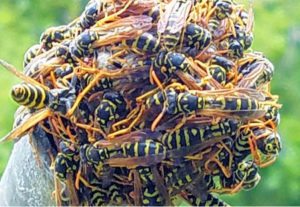
- The best piece of information about DIY stinging insect control is that many of the “wasp and hornet sprays” are contact sprays. There are two types of pesticides: Contact and Residual. Contact sprays are knockdown products. They kill the pest fast (so you don’t get stung), yet they don’t have a residual. Once contact sprays dry, they have no effect on the pest. Point being, if you are controlling a yellowjacket nest inside of a wall void/ crevice, contact sprays: 1. Likely won’t reach the actual nest. 4. Kill the pest before they can transfer the product to the nest. 3. Stop working before control is achieved.
- In many cases, these products can cause yellowjackets nesting inside walls to start coming inside the structure.
- Residual pesticides continue to control pests after the treatment has dried. Residual pesticides is one reason that bed bugs went nearly extinct. Older, now banned pesticides, had a long residual. People would apply them inside continuously. As a result, there was a semi-permanent “layer of protection” inside most households. Due to pesticides’ persistence in the environment, they were taken off the market. Now the proper way to control pests is not by spraying your baseboards. It is through integrated pest management. This includes monitoring pest levels and utilizing cultural and mechanical control methods over chemicals. On top of that, we now have baits for ants and roaches. Once these rolled out, the “layer of protection” wore out and bed bugs returned.
Many residual products also have the “benefit” of killing the pest quickly (kills on contact). Yet for social insects like ants and yellowjackets, you don’t really want that. The product needs to be transferred back to the colony to achieve control. Therefore, you want pesticides to kill them slowly.
Green products kill on contact. They are examples of “contact pesticides”. They have little to no residual effect. One of the reasons it is considered a green product.
Treating Yellowjacket Nests Inside Wall Voids:
- Use dust to treat yellowjacket nests inside a wall void, in a foundation wall, under siding, in a door frame. It has a residual effect and is easily transported back to the colony.
- A very light application is all that is usually required.
- Compare dust pesticides to snow. Would you walk through a giant pile of flaky white stuff more readily than you would a thin layer of it? The answer is no. And the same goes for insects. If you apply too much, the pest is just going to avoid it.
- A proper dust application should be hardly detectable.
Fleas:
- Treat pets professionally by the vet.
- Treat the interior.
- Treat shaded areas of the yard and under porches and decks.
- Remove potential sources (wildlife living under structures, feral cats, etc.)
- Retreat in 7-14 days.
Pantry Moths: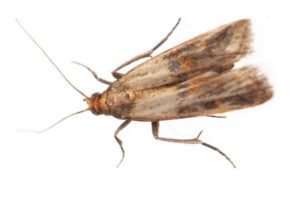
- Indian meal moths often come from the store in pet food or dried plant products such as rice, flour, and noodles. The insects can be in the house for months before they are numerous enough to be noticed. The original source of the infestation can be very difficult to trace.
- Alternatively, Indian meal moths can come from the exterior. Wildlife contamination hidden somewhere inside the structure, can cause recurring problems with this pantry pest. Common sources are old birds’ nests or other wildlife contamination inside of the chimney. Spent rodent food cache, such as acorn shells, can also start to break down inside the home and cause moths to be present.
- This unique pest can be controlled naturally by removing the food source of the larvae.
- We recommend that you go through all listed items and dispose of expired or infested products. Including: Cornmeal, flour, oatmeal, cereal, pancake/muffin mixes, nuts, rice, dog bones, dried pet food, crackers, pasta, dried fruit, protein powder and other drink mixes, bird seed, fish food, spices, seasoning packets, tea, soup mix, potpourri, dried floral arrangements, decorative corn stalks, deer antlers, bird and rodent nests, rodenticide bait, and feathers.
- Pheromone traps may also be placed around the structure to help locate hidden sources. We recommend placing a few traps away from the pantry. You do not want to draw more moths into your kitchen. So, place traps in the fireplace, by the chimney cleanout, along the basement rim joist, and in the attic, or attached garage. This will help determine if you purchased an infested product, or if the source lays hidden elsewhere inside the structure.
Small Flies:
- Flies are a sanitation issue.
- Identify the fly species.
- Find the source. This means the larval breeding sites.
- Remove the source. For most fruit fly problems, it helps to clean and then treat drains with bacterial enzyme cleaner.
Larval development areas are found in sweet or vinegar like solutions.
Produce- Onions, Garlic, Melons, Peaches, Bananas, tomatoes.
Garbage, garbage disposals, drains, coffee makers, dishwasher drains and filters, recycling can and bottles, animal and human excrement, mop heads, soiled linens (rags), refrigeration drip pans, food debris under trash can liners, spilled drinks/ syrup, other food that fell and got lost.
(Adult flies regularly rest near breeding sites, especially first thing in the morning.)
Sanitation Recommendations:
Clean floor areas under counters and appliances. Brush and flush floor drains and sink drains weekly. Pay attention to garbage disposals, especially the organic buildup that occurs under the rubber flange of the sink drain.
Eliminate standing water in condensate pans and in sinks, etc. Keep mop heads clean and hang them upright to dry. Remove and launder wash rags, sponges, and dirty linens at least twice per week. Move exterior trash receptacles as far away from entrances as possible.
Wash out beverage containers before placing them in recycling. And clean recycling bins and trash cans at least twice per week. Clean dishwasher filter. Clean or replace the dishwasher drain line if it has organic buildup in the line. Clean coffee or beverage maker filter and parts.
We do not recommend placing homemade fly traps in affected areas, since they may attract more adults into the area that you wish to gain control in.
Filth Flies: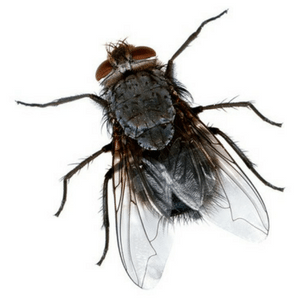
- There is poop, garbage or something died.
- Once again, flies are a sanitation issue.
- You should identify the pest, find the source of larval development and remove it.
Recommendations:
- Keep exterior trash receptacles at least 25 feet away from the structure.
- Promptly remove animal feces from the ground. Dispose of them in airtight bags.
- Attempt to limit the flies’ access through doors and windows.
Cockroaches: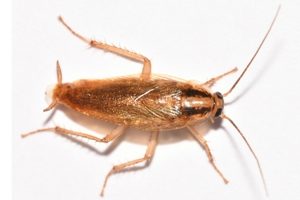
German Cockroaches are the species that infest our kitchens and bathrooms in Lakewood homes.
- Place many “Roach Motels”/ Sticky traps around the effected areas of the home.
- Leave them overnight.
- Remove sticky traps with roaches caught on them.
- Replace them with bait.
- Wait a few days.
- Reapply sticky traps.
- Repeat until control is achieved.
*It can take over a month to achieve control.
The most common area to find cockroaches is behind the fridge. Place bait in this area, along with under lip of countertops, behind splash guard on counter, and inside the back of cabinet bases.
#1 Rule When Applying Pesticides
Follow The Pesticide Label! The Label Is The Law.
Take the time to read the instructions.
1: This tells you where you can apply the pesticide.
2: This tells you what you need to do to protect yourself, other people, and the environment.


